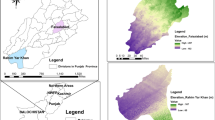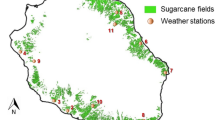Abstract
In this study, precipitation- and temperature-related indices were considered using Rclimdex software to study trend of climate extreme indices. Daily minimum and maximum temperature data retrieved from MPI-ESM-LR and ACCESS1-0 global climate model were used to predict future climate extreme events over the next three periods of 2026–2050, 2051–2075, and 2076–2100 based on IPCC scenarios of RCP4.5 and RCP8.5 of studied area covering South Khorasan province and southern part of Razavi Khorasan province, located in east of Iran; furthermore, future saffron yield was predicted based on the yield-extreme indices model. Results showed an increasing trend of warm climate extreme indices and a decreasing trend in precipitation indices as important factors in the decrease of saffron yield. Considering multiple regression yield model of saffron based on climate extreme indices, it was concluded that saffron yield decreases in future periods over studied area with the highest reduction of 31% in period of 2076–2100 under RCP8.5 scenario. Results also confirmed that yield reduction in all three periods under RCP8.5 scenario was greater than the same periods under RCP 4.5 scenario.








Similar content being viewed by others
References
Ahmed KF, Wang G, Silander J, Wilson AM, Allen JM, Horton R, Anyah R (2013) Statistical downscaling and bias correction of climate model outputs for climate change impact assessment in the US northeast. Glob Planet Chang 100:320–332
Atkinson D, Porter JR (1996) Temperature, plant development and crop yields. Trends Plant Sci 1:119–124
Barlow K, Christy B, O’leary G, Riffkin P, Nuttall J (2015) Simulating the impact of extreme heat and frost events on wheat crop production: a review. Field Crop Res 171:109–119
Behdani MA, Nassiri M, Koocheki AA (2003) Modeling saffron flowering time across a temperature gradient. I Int Symp Saffron Biol Biotechnol 650:215–218
Ewert F, Rounsevell M, Reginster I, Metzger M, Leemans R (2005) Future scenarios of European agricultural land use: I. estimating changes in crop productivity. Agriculture. Ecosyst Environ 107:101–116
Fallahi J, Rezvani MP, NasiriI MM, Behdani M (2013) Validation of RothC model for evaluation of carbon sequestration in a restorated ecosystem under two different climatic scenarios. J Water Soil:656–668
Halevy A (1989) Recent advances in control of flowering and growth habit of geophytes. V Int Symp Flower Bulbs 266:35–42
Hatfield JL, Prueger JH (2015) Temperature extremes: effect on plant growth and development. Weather Clim Extremes 10:4–10
Horie T, Baker JT, Nakagawa H, Matsui T, Kim HY (2000) Crop ecosystem responses to climatic change: rice. Clim Chang Glob Crop Prod:81–106
Im E, Jung I, Bae DJ (2011) The temporal and spatial structures of recent and future trends in extreme indices over Korea from a regional climate projection. Int J Climatol 31:72–86
Jin Z, Zhuang Q, Wang J, Archontoulis SV, Zobel Z, Kotamarthi VR (2017) The combined and separate impacts of climate extremes on the current and future US rainfed maize and soybean production under elevated CO2. Glob Chang Biol 23:2687–2704
Koocheki AA (2003) Indigenous knowledge in agriculture with particular reference to saffron production in Iran. I Int Symp Saffron Biol Biotechnol 650:175–182
Koocheki A, Nassir M, Jamali J, Marashi H (2006) Evaluation of the effects of climate change on growth characteristics and yield of rainfed wheat in Iran. Agric Sci 20:83–95
Kouzegaran S, Mousavi BM, Sanaeinejad H, Behdani MA (2011) Study of the minimum, average and maximum temperature in South Khorasan to identify relevant areas for saffron cultivation using GIS. J Water Soil 25:892–904
Kouzegaran S, Mousavi Baygi M, Sanaeinejad H, Behdani M (2013). Identification relevant areas for saffron cultivation according to precipitation and relative humidity in South Khorasan using GIS. J Saf Res 1(2):85–96. https://doi.org/10.22077/jsr.2013.436
Kouzegaran, S., Mousavi Baygi, M., Khashei-Siuki, A., Babaeian, I. (2018). Modeling of the Saffron Yield Based on Meteorological Extreme Events (Case study: Birjand). J Saf Res 5(2):217–229. https://doi.org/10.22077/jsr.2017.411.1017
Kouzegaran S, Mousavi Baygi M, Babaeian I, Khashei-Siuki A (2020) Modeling of the saffron yield in Central Khorasan region based on meteorological extreme events. Theor Appl Climatol 139:1207–1217
Lashkari A, Alizadeh A, Bannayan M (2011) Investigation of mitigation of climate change impacts on maize production in Northeast of Iran. J Water Soil 25:926–939
Lhomme J-P, Mougou R, Mansour M (2009) Potential impact of climate change on durum wheat cropping in Tunisia. Clim Chang 96:549–564
Menzel A (2000) Trends in phenological phases in Europe between 1951 and 1996. Int J Biometeorol 44:76–81
Molina R, Valero M, Navarro Y, Garcıa-Luis A, Guardiola J (2004) The effect of time of corm lifting and duration of incubation at inductive temperature on flowering in the saffron plant (Crocus sativus L.). Sci Hortic 103:79–91
Molina R, Valero M, Navarro Y, Guardiola J, Garcia-Luis A (2005) Temperature effects on flower formation in saffron (Crocus sativus L.). Sci Hortic 103:361–379
Parry ML, Rosenzweig C, Iglesias A, Livermore M, Fischer G (2004) Effects of climate change on global food production under SRES emissions and socio-economic scenarios. Glob Environ Chang 14:53–67
Pinya MAS, Hundecha Y, Lawrence D, Madsen H, Willems P, Martinkova M, Vormoor K, Bürger G, Hanel M, Kriaučiuniene J (2015) Inter-comparison of statistical downscaling methods for projection of extreme precipitation in Europe. Hydrol Earth Syst Sci 19:1827–1847
Powell J, Reinhard S (2016) Measuring the effects of extreme weather events on yields. Weather Clim Extremes 12:69–79
Sillmann J, Kharin V, Zhang X, Zwiers F, Bronaugh D (2013) Climate extremes indices in the CMIP5 multimodel ensemble: part 1. Model evaluation in the present climate. J Geophys Res Atmos 118:1716–1733
Sobhani B (2016) Agroclimatic zoning cultivation Saffron in Ardabil Province using of method AHP. J Saf Res 4(1):72–86
Tian J, Liu J, Wang J, Li C, Nie H, Yu F (2017) Trend analysis of temperature and precipitation extremes in major grain producing area of China. Int J Climatol 37:672–687
Author information
Authors and Affiliations
Corresponding author
Additional information
Publisher’s note
Springer Nature remains neutral with regard to jurisdictional claims in published maps and institutional affiliations.
Rights and permissions
About this article
Cite this article
Kouzegaran, S., Mousavi Baygi, M., Babaeian, I. et al. Future projection of the effects of climate change on saffron yield and spatial-temporal distribution of cultivation by incorporating the effect of extreme climate indices. Theor Appl Climatol 141, 1109–1118 (2020). https://doi.org/10.1007/s00704-020-03241-0
Received:
Accepted:
Published:
Issue Date:
DOI: https://doi.org/10.1007/s00704-020-03241-0




